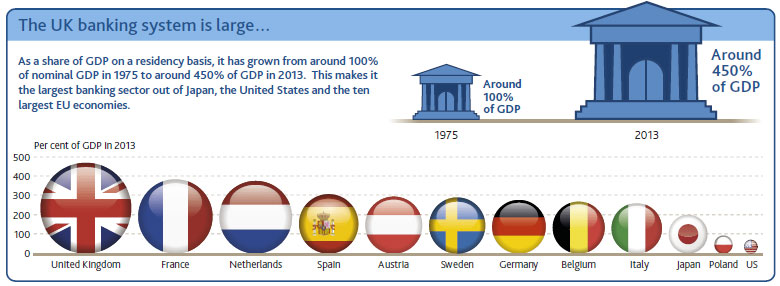The Bank of England just published a research paper “Financial Stability Paper 32: Estimating the extent of the ‘too big to fail’ problem – a review of existing approaches – Caspar Siegert and Matthew Willison”.
The disorderly failure of a large financial institution could cause widespread disruption to the financial system. Because of this, authorities have often in the past been reluctant to see large institutions fail and preferred to use public funds to save them. To the extent that this is anticipated by a bank’s debt holders, these ‘too big to fail’ (TBTF) institutions may benefit from funding costs that are artificially low and insensitive to risk, a form of implicit subsidy from the government. Implicit subsidies could lead to resource misallocation in the economy because institutions are incentivised to choose excessively high levels of risk since their funding costs do not fully reflect the level of risk-taking. Moreover, banks that are not yet TBTF may have incentives to grow to being inefficiently large, in order to boost their chances of receiving government support.
- First, the share price increase would reflect a TBTF bank’s lower debt costs since shareholders hold a residual claim on the bank’s profits. If an increase in the expectation that a bank will be bailed out reduces debt costs and these benefits are not fully passed on to the bank’s customers or employees this will increase expected profits and hence raise a bank’s share price. Thus, share price reactions could be an indirect measure of the impact of TBTF expectations on debt costs. But cross-sectional studies that compare TBTF and non-TBTF banks should fail to find this effect if they control for bank profitability.
- Second, a capital injection into a bank that would otherwise have failed may mean that shareholders’ claims are diluted rather than being wiped out entirely as they would be if the bank became insolvent. If existing shareholders are not wiped out entirely they are partially insured in case of failure and will demand lower expected returns in order to invest into the bank. Consequently, share prices will be higher for a TBTF bank than for a non-TBTF bank for a given level of bank profitability.
The existence of the TBTF problem is now widely accepted by academics, politicians and regulators across the world. In 2009, G20 leaders called on the Financial Stability Board (FSB) to propose measures to reduce the systemic and moral hazard risks associated with systemically important financial institutions (SIFIs). The FSB has developed a framework for addressing the TBTF problem that includes:
- Methodologies to identify institutions that are systemically important (for banks see Basel Committee on Banking Supervision (2013), for insurers see International Association of Insurance Supervisors (2013), and for non-bank,
non-insurer financial institutions see Financial Stability Board and International Organization of Securities Commissions (2014)); - Policies to reduce the likelihood of SIFIs failing such as additional capital requirements (eg Basel Committee on Banking Supervision (2013)) and enhanced supervision (Financial Stability Board (2012));
- Policies to reduce the impact of SIFIs failing by ensuring arrangements are in place to effectively resolve those institutions (see Financial Stability Board (2011)).
As part of its work on reducing the impact of the failure of a global systemically important bank (G-SIB) the FSB is currently consulting on policy proposals to ensure that G-SIBs have sufficient capacity to absorb losses in resolution without requiring public support or threatening financial stability (Financial Stability Board (2014)). The policy proposals on such ‘total loss-absorbing capacity’ were welcomed by the G20 leaders at their Brisbane summit in November 2014.
But it raises the question, how big is the ‘too big to fail’ (TBTF) problem? Different approaches have been developed to estimate the impact being perceived as TBTF might have on banks’ costs of funding. One approach is to look at how the values of banks’ equity and debt change in response to events that may have altered expectations that banks are TBTF. Another is to estimate whether debt costs vary across banks according to features that make them more or less likely to be considered TBTF. A third approach is to estimate a model of the expected value of government support to banks in distress. They review these different approaches, discussing their pros and cons. Policy measures are being implemented to end the TBTF problem. Approaches to estimating the extent of the problem could play a useful role in the future in evaluating the success of those policies. With that in mind, the report concludes by outlining in what ways they think approaches need to develop and suggest ideas for future research.

